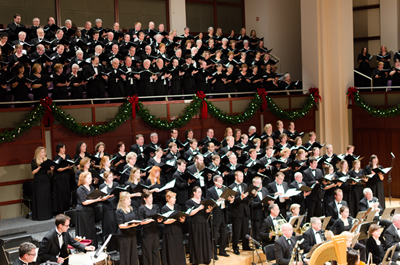A staple of American culture, Leonard Bernstein‘s West Side Story was revitalized at Meymandi Concert Hall as the film was shown above the North Carolina Symphony, which provided live accompaniment.*
This type of screening-turned-concert (as seen previously with The Wizard of Oz screening in 2012) sheds some light on what film orchestras do every day for a living, with probably equal or even less rehearsal time. The movie orchestra must wear headphones and rely on the conductor, who is watching for cues in the already recorded film. Similarly, NCS Artistic Director Grant Llewellyn had a small screen showing the movie with flashing cues and a click track playing through his earpiece, as did the principals and key players. The musicians, in true Broadway form, had stand lights and section microphones to optimize the visual and aural balance of the orchestra with the movie.
Llewellyn, who studied under Bernstein at the Tanglewood Music Center in Massachusetts early in his career, spoke about how his experience with the master influenced his interpretation of the score: “Never have I met a more charismatic and simply brilliant communicator than Leonard Bernstein. Those same qualities – charisma and brilliance – permeate the entire score of West Side Story, and I can’t wait to get my hands on it.”
Luckily for Llewellyn, charisma and brilliance were passed down from teacher to pupil, and now the North Carolina Symphony has had the chance to illuminate and reinvigorate the already vivacious score. The overture was energetic, “Mambo” was thrilling and chaotic in all the best ways, and the balance between enthusiastic body percussion and lively mixed-meter playing in “America” was phenomenal. Llewellyn gave a lithe performance that matched the scoring and timing in the movie and left room for flexibility and expression.
All the flair and class of this highly trained orchestra lent itself perfectly to a fluid performance of one of America’s most beloved musicals. Having the orchestra playing live was wonderful in highlighting Bernstein’s inventive scoring and downplaying some of the more goofy moments in the movie. Personally I have always felt that moments like the carefully choreographed knife fight could benefit from more present music. The first time Tony and Maria pause to consider their future together, the second violins hint at the melody from “Somewhere,” and the contrast between the silence and the delicate playing of the live orchestra truly made this moment shine.
The only real timing issues – besides those of singers not syncing with each other in the original soundtrack recording – came from transparently orchestrated percussion parts, with very exposed maracas or cymbals on offbeats. This could have been an issue of phasing across the large space and the sounds from the movie not reaching the ears of the listener at the same rate as the percussionists, who were much farther upstage.
To expound upon an observation by Bernstein music editor Garth Edwin Sunderland that I read in the program, the “flourishes that could only exist within the limitless bounty of an MGM recording studio” present great challenges to the live orchestra. The “six saxophones, eight trumpets, and in one particularly thrilling passage, five xylophones, doubled by five pianos!” are simply impossible and impractical for this type of performance. However, Sunderland’s orchestration for live orchestra presents the opportunity for soloists to truly shine. Concertmaster Brian Reagin and Associate Concertmaster Dovid Friedlander shared beautiful features with finesse, piccoloist Elizabeth Lunsford got to play delicate solos and raucous, soaring solos over the whole orchestra, and principal hornist Rebekah Daley also had gorgeous moments.
This is the way I would recommend seeing West Side Story if you have not yet seen it. If you have but didn’t enjoy it as a movie, I also recommend coming to see it again with the full effect of having such an impeccable ensemble as the North Carolina Symphony sitting right before you. Honestly, I feel that the movie – or at least the ballet-dancing gang members in the first half – is a little too popular for what it is, but as a vehicle of master Bernstein’s groundbreaking work, it is a must-see! You’ll have one more chance to experience West Side Story this way on September 27 at 8 p.m., but seating is extremely limited! For details, see the sidebar.
* 518 West Italian Café in Raleigh hosted Marsha Gordon, Associate Professor of Film Studies at N.C. State University, and Laura Boyes, Film Curator at the NC Museum of Art, for a pre-concert dinner and discussion of West Side Story.












